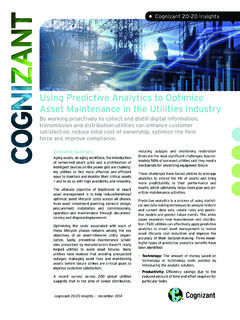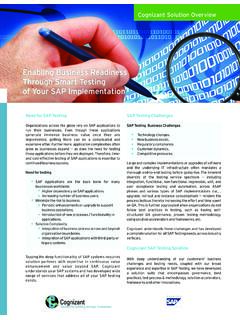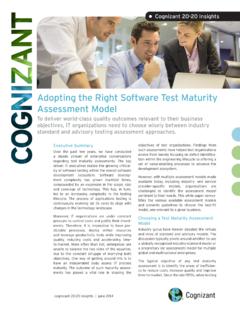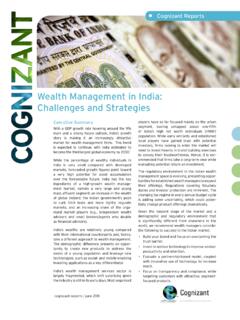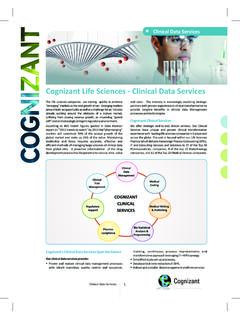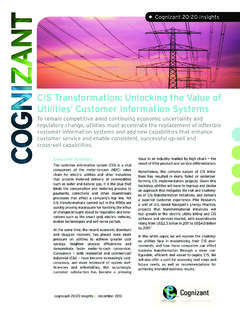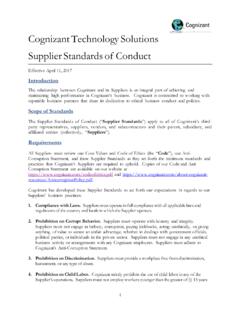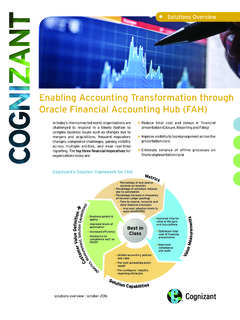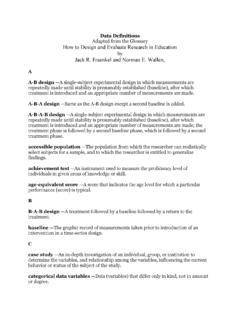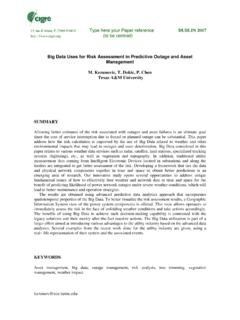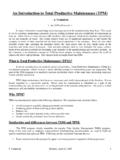Transcription of Predictive Analytics: Accelerating & Enriching …
1 Predictive analytics : Accelerating & Enriching product DevelopmentWhile product developers are familiar with Predictive analytics , they often lack clarity when it comes to understanding how these tools can contribute to the success of new product concepts. Executive SummaryProduct development is all about Accelerating innovation, strengthening quality, speeding time to market, and keeping costs in line. By incor-porating Predictive analytics into the process, companies can sharpen their forecasts; better predict product performance, failures, and down-time; and generate more value for the business and its customers. A digital mock-up of 3D geometry is no longer enough because products are no longer just 3D mechanical creations. While new aspects of prod-uct development ( idea to launch ) continue to garner a lot of attention, integrating Predictive analytics into the process can be challenging requiring companies to thoroughly assess their strategic goals, their appetite for investment, and their willingness to experiment.
2 This paper explores scenarios that are relevant to Predictive analytics in product development and presents an approach for applying 20-20 Insights | January 2018 COGNIZANT 20-20 INSIGHTSC ognizant 20-20 InsightsPredictive analytics : Accelerating & Enriching product development | 2 DERIVING MORE VALUE FROM DATAT oday, companies must rely on insights gleaned from the massive amounts of data they accumu-late from various channels. While the Internet of Things (IoT) offers a trove of real-time informa-tion via smart, connected devices and things, challenges (detecting failure patterns, modeling correlations, predicting failures, prescribing rem-edies, and prioritizing recommendations against cost constraints, for example) remain. While organizations worry about the cost of new products and the expected ROI, consumers care about a product s value/price ratio, its level of innovation and, of course, its quality.
3 Predictive analytics can help mitigate these concerns and meet the expectations of both the business and its customers. Questions for Executives Executives responsible for product develop-ment face a bevy of critical questions every day. Among them: What factors and attributes will determine the company s success in product development ? What external dynamics (customer needs and behaviors, market and technology trends) and internal considerations (capabilities and culture) will contribute to our products per-formance in the marketplace? How do we leverage the technologies, skills, and knowledge that will optimize customer- centric product breakthroughs?Aside from these concerns, many companies have limited tools at their disposal, and must rely heav-ily on experience, guesswork, and trial and IN product development Organizations have long relied on traditional prod-uct- development tools and approaches, including FMEA, CAD simulations, design of experiments, and value stream analysis, to heighten efficien-cies, eliminate waste, and optimize costs.
4 However, given the ever-increasing volumes of data that flow into and through companies, con-ventional product - development technologies and tactics are no longer sufficient. (See Figure 1). Traditional Tools & Approaches 3D Computer-Aided Simulation (CAE), Virtual RealityProducts are becoming more complex with the inclusion of softwareFailure Mode &Effect Analysis (FMEA)Based on experience rather than dataDesign of Experiment (DOE)Analysis of influences and responses methodologies can produce sub-optimal resultsValue Stream AnalysisGives a retrospective, rather than Predictive , viewFigure 1 Cognizant 20-20 InsightsPredictive analytics : Accelerating & Enriching product development | 3 Although product developers continually look for better ways to handle the abundance of data at their disposal, most don t have the right tools to manage it, make sense of it, or apply the insight it provides to support future product companies know that data-driven insights and decisions can help improve all aspects of product development .
5 According to McKinsey s global survey, many are already applying big data/ analytics to: Improve research and development (R&D) Develop new product strategies Identify new market segments Deepen customer knowledge/relationships Improve customer segmentation and targeting Develop differentiating and dynamic pricing strategiesMaking the Case for Predictive AnalyticsPredictive analytics applies across the prod-uct- development value chain. (See Figure 2). Predictive analytics Across the Value ChainCrowdsourcing and social media play a significant role in collaborative product from suppliers manufacturing process-es and materials can aid in better design and accelerate time to from previous product performance help in maintaining the right product of intellectual property provides crucial information to design a legally sound data provides information about how a particular component was designed, plus insights into challenges that were encountered.
6 Logics and rules from this data will help design new parts and assem-blies and promote standardization by harvesting old parts from existing from manufac-turing equipment and processes help improve Design for Manufacturing. BOM (bill of materials) analysis helps set the right product concerning hazardous materials, legally restricted substances and small components, for example, help assure regulatory compliance and aid in faster product on transport conditions (weather, humidity, etc.) helps in developing the right packaging from quality inspections and third-party lab testing can provide vital information for product on local laws helps assure appropriate product / packaging/labeling from local markets help in launching customized variants and fine-tuning products to suit various consumer insights from product development aid in launching the product at the right data analytics help refine existing designs and develop specifications for new models and manufac-turers can capture the data generated from warranty claims, spares, and service, and use it to develop better recalls, although very expensive.
7 Provide crucial insights into flaws in the product development process and provide opportuni-ty for & ConceptEngineering & DesignDevelopment & ValidationPre-Production/ CommercializationLaunch & After-MarketFigure 2 Cognizant 20-20 InsightsPredictive analytics : Accelerating & Enriching product development | 4 Quick TakeThe Potential of Predictive analytics in product DevelopmentPredictive analytics brings together advanced analytic capabilities spanning ad-hoc statistical analysis, Predictive modeling, data mining, optimization, machine learning and more to help companies: Transform volumes of data (internal and external) into measurable, action-able information Improve the speed and quality of decision making Develop forward-looking rather than retrospective strategies Evolve into a data-driven, insight-based organization Shift decision making from an executive-level task to an all-employee pursuit Use digital capabilities to deliver insights and knowledge across the organization.
8 Cognizant 20-20 InsightsPredictive analytics : Accelerating & Enriching product development | 5 Navigating Critical Phases of Data Modeling Data modeling in the concept and feasibility stages of product development incorporates the following steps: 1. Gather past and present product attributes and Model the relationship and correlation between the Capture product performance from market and test data; identify features that are most desired/in demand. 4. Establish an algorithm to determine the per-formance of future products based on these attributes. Let the model predict the combi-nation of Balance the above with business logic and organizational 3 illustrates the phases of high-level data modeling. The Stages of High-Level Data Modeling DESCRIBEU nderstand the business problemINTEGRATEC ollect data on product performance (KPIs)ENRICHMine the historical data on internal/external factorsANALYZEC reate a model to predict performanceVALIDATEUse the business logic to optimize and finalize the modelFigure 3It is important to note that data modeling is a highly collaborative process that engages all stakeholders, including design partners and com-ponent vendors.
9 Given that Predictive analytics is applicable at every stage of product develop-ment, one-step, one-stop approaches are likely to fail. Hence, data analytics capabilities should be embedded in every phase of product devel-opment to gather insights and drive innovation from various perspectives. Data models should remain in sync with product models to ensure that simulation and testing reflect real-world scenarios at every stage of development , and build confidence that a prod-uct will meet customers expectations. Predictive analytics & product Lifecycle Management Predictive analytics speaks to the key aspects of product development : time to market, cost, qual-ity, and compliance. By embedding this capability in product Lifecycle Management (PLM) systems, companies can significantly enhance innovation by using quantitative data to shape decisions and outcomes and sharpen their competitive advan-tage.
10 Lately, many PLM service providers have started to build robust Predictive analytics capa-bilities. PTC (formerly Parametric Corporation) acquired big data machine learning and predic-tive analytics leader ColdLight. Siemens released Simcenter, an end-to-end simulation platform. Cognizant 20-20 InsightsPredictive analytics : Accelerating & Enriching product development | 6 There are numerous areas where Predictive ana-lytics can play a significant role in PLM: Feature-based search Cost analytics Regulatory compliance Program management Configurable dashboards Organizational KPIs Environmental compliance product portfolio analysis product quality Incorporating Predictive analytics into PLM sys-tems helps derive and deepen insights during the product development process across multiple functions.
